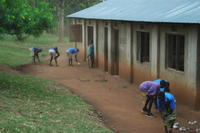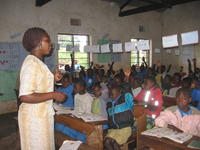Teaching and Learning at Kasiisi School
Entebbe, Uganda
Thursday, August 11, 2005
 When children arrive at Kasiisi School between 7 and 8 AM, many or most carry out daily cleaning tasks, sweeping classrooms with grass brooms that they make at home (photo), picking up litter on the grounds, and so forth. Assembly on the football field is at 8 AM, followed by very orderly and very quiet streaming of children to their classrooms.
When children arrive at Kasiisi School between 7 and 8 AM, many or most carry out daily cleaning tasks, sweeping classrooms with grass brooms that they make at home (photo), picking up litter on the grounds, and so forth. Assembly on the football field is at 8 AM, followed by very orderly and very quiet streaming of children to their classrooms.The school has 5 blocks of classrooms and offices. All have been built since 1997 through the tremendous good works of Elizabeth Ross of Weston, along with her husband Richard Wrangham and her sister-in-law Catherine Wrangham-Briggs. Funds have come from Weston Field School, Weston Middle School, First Parish Church and St. Peter's Church in Weston, and interested and generous families from Weston and other communities. The Uganda government began supplying additional funds after it became clear that this school was on a successful track.
One block of two classrooms remains unfinished. It has end walls and a roof, but no side walls. Side wall construction was designated as a project for local parents. Lack of time, funds and organization among them continues to delay this work.
Classes go from P1 to P7, where P1 corresponds to our kindergarten and P7 is equivalent to our sixth grade. Total enrollment now is about 1,100. Daily attendance is typically between 800 and 900, heavily skewed to the lower grades. On a recent day the attendances for P1-P7 were 200, 139, 128, 95, 109, 97 and 57 respectively. Children in P1 and P2 go home after 1PM, the rest after second assembly that convenes at 4PM.
The school year has three terms with 2-week breaks between successive terms. There is no long vacation as we have. The terms start in January, May and September. Right now the students at Kasiisi are studying for their end-of-term exams, which will commence in another week or so. Most of the teaching and learning right now is review (called revision here) and drill in preparation for exams.
The day is broken up into three sets of three successive 40-minute classes that go 8-10 AM, 11AM-1PM, and 2-4PM (for P3-P7 only). Subjects include English, mathematics, social studies, science, agriculture, home economics, and Christian religious education - Uganda as a country has been officially Christian since the early 1900s. As noted earlier, there are assemblies at 8 AM, 2 PM and 4 PM. The 8 AM assembly features the Uganda national anthem and the Toro anthem, from the Kingdom of Toro, which still exists in a strong ceremonial and cultural sense and is centered in nearby Fort Portal. The 4 PM assembly includes singing of the Lord's Prayer. The Friday midday assembly is dedicated to education about HIV and AIDS. Kasiisi School has its own heraldic crest. The school's motto is "Knowledge is Wealth".
Curriculum changes in Uganda every 5 years or so. The national primary curriculum comprises two very large volumes. Teachers prepare their daily lessons based squarely on the curriculum. There is little improvisation outside its guidelines. Classes at Kasiisi are conducted in the local language, Rutooro, for P1-P4 and entirely in English thereafter. Children begin English classes in P1.
Kasiisi has 18 teachers plus an assistant to headmistress Elizabeth (Lydia) Kasenene. Like the children, the teachers walk to work from nearby apartments or villages. Some ride bicycles. Teachers and police are among the lowest paid civil servants in Uganda. A primary teacher earns about $80 per month on average. Paychecks often arrive late. Few teachers are married. Most teachers are sharing their incomes with their extended families.
Headmistress Elizabeth runs a very tight, clean, organized and disciplined school. It is the highest-rated primary school in Kabarole District, which has some 100 primary and secondary schools serving about 600,000 total population. Elizabeth drives her car to school, which is probably quite unusual in this rural area.
Much or most of the work done at school in America by assistants and custodial staff is done at Kasiisi by students, including gathering and organizing printed materials, moving chairs, cleaning the rooms and grounds, and so forth.
 Teachers come extremely well prepared for their lesssons, in our observation. Classes are organized similarly across all grades. The teacher drives everything, starting with a verbal/oral introduction to the lesson's materials. Everything is done through recitation in unison. After an initial introduction the teacher will stop speaking after every few words, say "what?", and the children will respond in unison with the word or short phrase that is being elicited. The teacher continues by writing a few examples of the lesson subject on the blackboard in chalk. He/she will ask for a volunteer to read one of the examples. Many hands shoot up. No child speaks until called on to speak. The selected child stands and reads, or recites, or spells, or whatever is called for. The teacher and students work out the examples together.
Teachers come extremely well prepared for their lesssons, in our observation. Classes are organized similarly across all grades. The teacher drives everything, starting with a verbal/oral introduction to the lesson's materials. Everything is done through recitation in unison. After an initial introduction the teacher will stop speaking after every few words, say "what?", and the children will respond in unison with the word or short phrase that is being elicited. The teacher continues by writing a few examples of the lesson subject on the blackboard in chalk. He/she will ask for a volunteer to read one of the examples. Many hands shoot up. No child speaks until called on to speak. The selected child stands and reads, or recites, or spells, or whatever is called for. The teacher and students work out the examples together. There is extraordinary discipline, yet almost no calls for discipline or order from the teacher. In our many hours sitting in classes at Kasiisi, we saw only one or two very brief and very matter of fact statements to children related to discipline. When the teacher leaves the room the children remain almost totally quiet, only a slight whispering among them, hardly enough even to hear. On one occasion we sat for some 20 minutes after the teacher had been called away to meet visitors; the class of 60+ students remained absolutely quiet and calm throughout - and it was not because we were present - we asked, and we saw similar things happen later in our visits.
There is extraordinary discipline, yet almost no calls for discipline or order from the teacher. In our many hours sitting in classes at Kasiisi, we saw only one or two very brief and very matter of fact statements to children related to discipline. When the teacher leaves the room the children remain almost totally quiet, only a slight whispering among them, hardly enough even to hear. On one occasion we sat for some 20 minutes after the teacher had been called away to meet visitors; the class of 60+ students remained absolutely quiet and calm throughout - and it was not because we were present - we asked, and we saw similar things happen later in our visits.After presenting and reciting examples interactively, the teacher writes several more related questions on the blackboard. Children copy them verbatim into composition books, in pen, and write the answers down. The teacher circulates among the students and corrects their work as it is being completed. Much of the marking happens right then and there. The teacher will finish marking the composition books later, during school hours. Children take their books and pens home with them each night. The children use only these composition books except for rare special occasions when textbooks or other books are made available. In nearly all cases, there are nowhere near enough books for each child to work from his or her own.
During recitation, if a child does particularly well, the teacher calls on the students to clap. They respond vigorously with clap-clap-clap, clap-clap-clap, CLAP. This kind of praise is quite rare, maybe once per class. Teachers do not praise effusively, and they also do not criticize. If a responding child makes a mistake, the teacher matter of factly goes to another volunteer. There is a distinct rhythm and pace to the teaching and learning. In classes of 30 to 100+ students, the approach and the techniques seem to work very well. Maybe the Ugandans have found, through long experience, the best way to work in very large classes of children who are mostly learning in a second language, English.
Children ask no spontaneous questions, and teachers apparently never solicit questions. Teachers in P4 and above will sometimes speak quickly in the local language, Rutooro, to make a complex point or to ensure that they are understood. The teacher will call on a child to get an eraser from the next room and clear the blackboard, which is not a real blackboard but actually a special black paint on the cement wall. Children are often taken out of ongoing classes in ones or twos to do some small job like moving chairs from room to room.
In the face of many, many obstacles unfamiliar to us, these teachers and these schools are doing an extraordinary job of preparing the next generation. It's humbling, and exalting, to see such effort and such skill and such dedication being applied, day in and day out, with the most rudimentary of materials.

1 Comments:
Hi Ms. Stevens
This is Anna Been, and I'm going into 9th grade at WHS. (I had Mrs. Schopfer for 5th grade.) What you are doing sounds just fantastic, and I just got back from a program in Zambia last week. We worked with children in the Sankandi Primary school and were able to teach them classes (translated into their native language.) What you are doing is just phenomenal. You are really making a difference.
Anna Been
Post a Comment
<< Home